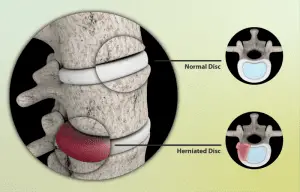Inversion therapy involves hanging upside down, which allows the spine to decompress and takes the pressure off the disc. Don’t worry, you won’t be hanging upside down for long – just a few minutes at a time.
Contents
How Using an Inversion Table Helps With a Herniated Disc
If you’re looking for a way to naturally relieve the pain of a herniated disc, you may want to consider using an inversion table. Inversion therapy is a type of spinal decompression that can help alleviate the pressure on your spine, as well as reduce the irritation of muscles and tissues.
Teeter inversion tables are some of the highest quality and safest tables on the market, with solid construction and easy operation. They are also third-party tested and certified to meet stringent safety standards.
When using an inversion table for herniated disc pain relief, it’s important to start slowly and carefully at first. Check with your healthcare provider to see if inversion therapy is right for you, and then follow the instructions that come with your table.
Can an Inversion Table Help Provide Low Back Pain Relief?
An inversion table is a device that allows people to hang upside down, with their feet above their heads. This position can provide relief from back pain by decompressing the spine. Inversion therapy has also been shown to be effective for other conditions, such as neck pain and headaches.
One study found that using an inversion table was helpful for people with a herniated disc. Participants who used the inversion table had less pain and disability than those who didn’t use the table. The inversion group also had a better quality of life than the non-inversion group.
Another study looked at the effects of inversion therapy on people with degenerative changes in their spine. The study found that inversion therapy was helpful for pain relief and improving the range of motion.
In general, inversion therapy is a safe and effective treatment for low back pain. However, it’s important to talk to your doctor before starting any new physical therapy program. If you have a herniated disc, your doctor may recommend avoiding inversion therapy altogether. In rare cases, herniated disc surgery may be necessary to relieve pain and improve function.
Breakdown of the research
A herniated disc is a very common condition that can cause a lot of pain and discomfort. If you have a herniated disc, you may be wondering if an inversion table can help.
Inversion therapy is a type of physical therapy that involves hanging upside down or at an inverted angle. It’s thought to decompress the spine and relieve pressure on the discs and nerves.
A 2012 study looked at the effects of inversion therapy on people with a herniated disc. The participants were divided into two groups: one group received physical therapy and the other group received inversion therapy. The study found that both groups had significant improvements in pain and function after 12 weeks. However, the group who received inversion therapy had better outcomes overall.
Another study from 2015 found that inversion therapy was effective at reducing low back pain and disability in people with a herniated disc. The study participants were given either inversion therapy or sham therapy (a fake treatment). The people who received inversion therapy had significantly greater improvements in pain, disability, and quality of life than the sham group.
There’s also some evidence that inversion therapy can help prevent herniated discs. A 2018 study found that people who used an inversion device for four weeks had a significantly lower risk of developing a herniated disc than those who didn’t use the device.
If you’re considering inversion therapy for your herniated disc, it’s important to speak to your doctor first. In some cases, surgery may be the best option for treating a herniated disc.
How Long Should You Invert For?
In short, it depends on everyone and anything can help. However, the ideal duration for a session of inversion therapy is 20 to 30 minutes. This is because relief may occur after just a bit of inversion, but the sweet spot is around 20-30 minutes. Anything beyond that may cause dizziness or headaches.
A Few Other Considerations
A few other things to keep in mind when using an inversion table are:
- If you have uncontrolled high blood pressure, you should not use this device. The same goes for those with uncontrolled low blood pressure or a history of head or chest problems.
- The inversion effect can cause an increase in intraocular pressure. If you have had recent cataract surgery or have retinal degeneration, please consult with a physician before using an inversion table.
- There is a “stretch reflex” associated with inverting the body that can cause pain. The key is to go slowly at first and find the angle that is most comfortable for you. Many people find that pre-treating with ice can help reduce the pain response.
Frequently Asked Questions
Can an inversion table heal herniated discs?
There is no evidence that inversion tables can heal herniated discs, but they may provide some relief from the pain associated with the condition.
What do you do with your arms on an inversion table?
There is no one answer to this question as people can use inversion tables for different purposes and in different ways. Some people might use inversion tables to do yoga or other exercises, while others might use them for physical therapy or to relieve back pain. In general, people will either keep their arms close to their sides or stretch them out in front of them while on an inversion table.
How can I decompress my spine at home?
There are many ways to decompress your spine at home, but some of the most effective include: Yoga, Pilates, Stretching, Myofascial release, and Foam rolling. If you have chronic back pain, it is important to consult with a spine specialist before beginning any at-home treatment program.
inversion table, inversion tables, inversion therapy, slipped discs, herniated disc, spinal discs, high blood pressure, herniated discs, back pain, disc pain, physical therapy, spinal nerves, first-time users, gravitational pressure, disc herniation, lumbar instability, lumbar support, solid solution, soft centers, uncomfortable symptoms, back area, Georgetown University, l4-l5 spine segment, small exercises, heating functions, spinal discs, certain factors, slight inclines, unique circumstances, health risks, different forms, slipped disc, chronic back pain, sciatica, annulus, lower back pain, intervertebral disc, bulging disc, herniated spinal disc, spinal disc, ruptured disc, degenerative disc disease, herniated, lower back, herniated disk, herniations, piriformis, spine, disc herniation, back pain
Final Thoughts
 If you are considering using an inversion table for a herniated disc, there are a few things you should keep in mind. First, if you have had any previous head or chest problems, you should consult your doctor before doing any type of inversion therapy.
If you are considering using an inversion table for a herniated disc, there are a few things you should keep in mind. First, if you have had any previous head or chest problems, you should consult your doctor before doing any type of inversion therapy.
Second, while an inversion table can be a good addition to a recovery program, it is not a cure-all and should be used in conjunction with other treatments prescribed by your doctor.
Third, while most people can use an inversion table without any problems, some people may have instability issues that make it unsafe for them to do so. Always consult your primary physician before beginning any new treatment program.
In conclusion, an inversion table can be a helpful accessory tool for managing pain associated with a herniated disc or scoliosis. However, it is important to use it in the proper context and not rely on it as the sole treatment method.

Dave Lee is the founder of Spine Institute NY, a huge fan of inversion therapy, a researcher, and an author.

